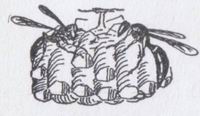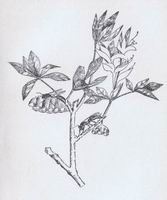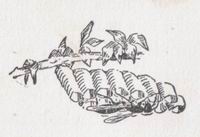|
1999-2004 (Return to Web Text-ures) |
Click Here to return to |
|
1999-2004 (Return to Web Text-ures) |
Click Here to return to |
POLISTES
 POLISTES is a charming little social wasp, with
the paper-building instinct on one hand, and the general appearance of the
solitary wasp on the other.
POLISTES is a charming little social wasp, with
the paper-building instinct on one hand, and the general appearance of the
solitary wasp on the other.
Her pretty paper combs are hidden away in bushes, or hung up in out-buildings, and they are never covered with a protecting outer wall. She has no fear of fresh air, and her offspring grow up blown about by every breeze that passes their dainty cradle cells. Her nest is small compared with that of Vespa, and her family are few in numbers.
In form she is long and slender, and in colour she is brown with reddish spots on the big end of her abdomen, and sometimes with one or more yellow rings about her body.
She has a little flat tongue, like Vespa, and seeks nectar upon the flowers that Vespa visits. Only the females live through the winter, each one starting her own nest in the spring. She begins with a little group of three cells, like Vespa, and her comb grows in diameter until it may become as large as the palm of one's hand. Sometimes when a particularly fine place is discovered, a number of wasps occupy it, building their combs so close together that they look like one broad sheet.
Once these wasps completely lined with their combs the shelter that covered the skylight window of an artist's studio.
If they had done it with the deliberate intention of displaying themselves, they could not have chosen a better position.
One standing below could look up through the window-glass directly into the open mouths of the cells, as the nests hung suspended from the shutter, and thus all that was going on could be safely observed.
Polistes is very careful about strengthening the little stalk that supports her nest. Vespa usually attaches her structure by the broad roof of the outer covering, or if it hangs in a tree, builds it about one or more branches so that it is very firmly fastened, but Polistes has only the slender support, or pedicel, in the centre or at one end of hers, to hold it in place, and this little paper stalk she licks again and again, laying on thick layers of sticky, glue-like saliva until it shines as though it had been varnished.
It is easy to take the nest of Polistes, as she makes very little resistance.
Indeed, one can cut the nest down and carry it off, wasps and all, with very little danger of getting stung.
Once a nest about two inches in diameter, was taken with half a dozen wasps on it. Some of the cells were occupied by larvae in different stages, while others were capped over, and still others contained eggs. It was necessary to keep the nest shut up in a box for several days, and in that time the confined wasps, perhaps becoming crazed by adversity, so far forgot themselves as to pull the larvae out of the cells and suck their juices.
Wishing to save some, if possible, the captor removed the unnatural nurses, and undertook the delicate task of feeding the larval infants herself.
Holding up the little nest by its stem to investigate the state of affairs, she discovered four full-grown, but still hungry larvae, with protruding heads and wide-open mouths.
Their foster-nurse offered one a drop of maple syrup on the end of a wooden toothpick, and to her delight the larval infant greedily sucked it up.
One by one the appetites of the four were finally satisfied -- though it seemed for a time as though their guardian's whole life must needs be devoted to these ravenous foundlings.
For three weeks they were fed several times a day alternately on maple syrup and raw egg, and it began to seem as though they had given up all intention of proceeding with their natural lives, and had resigned themselves to an indefinite orgy of maple syrup and egg. Did ever wasp larvae remain larvae so long? They must have gone at least two weeks over their time before they began to show signs of spinning.
Then, one day, when their rations were proffered them, fine, sticky threads adhered to the toothpick, and their weary but patient nurse joyfully realised that at last they were going to “take a rest,” and give her one too.
Nor were her hopes vain. One spun a thin, delicate, almost transparent cocoon, and unkindly did it in the night, when it could not be observed. By morning the ungrateful larva had retired from view.
The next, however, rewarded its nurse's patient care by beginning operations in the middle of the afternoon under her very eyes, and as she watched the dainty weaver she felt fully repaid for three weeks' unremitting administration of syrup and egg in toothpick portions.
First the larva lined its cell, turning its head down under its body, arid also turning around and around in the cell.
Then it began to build the cell walls higher, for the wasps, in anger or despair or for some other reason, had chewed down the edges of its cell before they were removed, so that it was not long enough to contain a full-grown wasp.
The hand fed larva knew this, and so it laboriously spun a top story to its room, and then built over its head the prettiest rounded dome of snow-white silk.
Its silken covering was not so thick as that of the wasps reared on the natural food of wasps, but it was very perfect as far as it went, and so thin that the larva could easily be seen through it.
The larva remained its own white, grub-like self for several days, and then- one day the nest was examined, and there shone through the thin cocoon the face of a wasp!
The hand-fed larva had actually transformed. Weeks passed and it did not come forth. Finally the cell was opened, and it was found-dead, with its wings not formed. It had done its best, but too much turning up the wrong way, -- for the nest had to be inverted to feed the larvae, -- or more probably an innutritious diet, had defeated its efforts, so that it had not quite enough vitality to make a complete transformation.
The third larva spun so delicate a cocoon that one day when the comb was suddenly turned down, the silken cap could not hold the weight of the now motionless pupa, and it fell crashing through, -- an accident which terminated fatally, as once exposed to the air it could not transform.
The fourth larva gave up the unequal contest and died without attempting to spin, and the one that spun first also died in its cell without developing its wings.
 It is an easy matter to tame Polistes,
particularly if the nest is taken early in the season before many wasps have
hatched out.
It is an easy matter to tame Polistes,
particularly if the nest is taken early in the season before many wasps have
hatched out.
Although the adult wasps were all removed from the nest described, others soon hatched out and they were so tame that the nest could be picked up while they were on it without exciting their displeasure.
The drones that hatched from this nest all had white faces, although the faces of the other wasps were brown.
Like other drones these also had long antennae, by which, and their white faces, they could be recognised at a glance.
Sir John Lubbock once took a specimen of Polistes with her nest, in the Pyrenees early in May. She became very tame, and lived till near the end of February.
Sir John Lubbock's account of her death is quite touching.
“One day,” he says, “I observed she had nearly lost the use of her antennae, though the rest of the body was as usual. She would take no food. Next day I tried again to feed her; but the head seemed dead, though she could still move her legs, wings, and abdomen. The following day I offered her food for the last time; for both head and thorax were dead or paralysed; she could but move her tail, a last token, as I could almost fancy, of gratitude and affection.
“As far as I could judge, her death was quite painless; and she now occupies a place in the British Museum.”
 Like Vespa, Polistes leaves the nest at the
approach of cold weather; the queens, after mating, find a safe place in which
to pass the winter, and the drones play about in the sun until they succumb to
the inclemency of the season.
Like Vespa, Polistes leaves the nest at the
approach of cold weather; the queens, after mating, find a safe place in which
to pass the winter, and the drones play about in the sun until they succumb to
the inclemency of the season.
A number of these homeless drones were once watched on a Massachusetts hillside.
They had long, drooping antennae and white faces.
Each had its favourite rock where it took its station on the sun-warmed south side, and none would allow another to come near its place.
When one, perhaps tired of his own rock, tried to sun himself on his neighbour's boulder, there was trouble. The invaded wasp flew at the intruder; they grappled and rolled head over heels among the leaves; then the original occupant returned in triumph to his rock, and the intruder flew away.
There was room enough on each boulder for any number of wasps, but only one might sit there at a time.
The observer could not decide whether some favourite wasp game, like foot-ball or tennis, was being played, or whether these drones really hated the sight of each other.
Polistes is a wise little creature in the things that pertain to wasps, and Mr. Belt has told an interesting story of the intelligence of one of the family in finding her way back to an object she had left.
He says, --
“A specimen of Polistes carnifex was hunting about for caterpillars in my garden. I found one about an inch long and held it out towards it on the point of a stick. It seized it immediately, and commenced biting it from head to tail, soon reducing the soft body to a mass of pulp. It rolled up about half of it into a ball, and prepared to carry it off. Being at the time amidst a thick mass of a fine-leaved climbing plant, it proceeded before flying away, to take note of the place where it was leaving the other half. To do this, it hovered in front of it for a few seconds, then took small circles in front of it, then larger ones round the whole plant. I thought it had gone, but it returned again, and had another look at the opening in the dense foliage down which the other half of the caterpillar lay. It then flew away, but must have left its burden for distribution with its comrades at the nest, for it returned in less than two minutes, and making one circle around the bush, descended to the opening, alighted on a leaf, and ran inside. The green remnant of the caterpillar was lying on another leaf inside, but not connected with the one on which the wasp alighted, so that in running in it missed it and soon got hopelessly entangled in the thick foliage.
 “Coming out again it took another circle, and
pounced down in the same spot again, as soon as it came opposite to it. Three
small seed-pods which here grew close together formed the marks that I had
myself taken to note the place, and these the wasp seemed also to have taken as
its guide, for it flew directly down to them, and ran inside; but the small leaf
on which the fragments of caterpillar lay, not being directly connected with any
on the outside, it again missed it, and again got far away from the object of
its search. It then flew out again, and the same process was repeated again and
again.
“Coming out again it took another circle, and
pounced down in the same spot again, as soon as it came opposite to it. Three
small seed-pods which here grew close together formed the marks that I had
myself taken to note the place, and these the wasp seemed also to have taken as
its guide, for it flew directly down to them, and ran inside; but the small leaf
on which the fragments of caterpillar lay, not being directly connected with any
on the outside, it again missed it, and again got far away from the object of
its search. It then flew out again, and the same process was repeated again and
again.
“Always when, in circling round, it came in sight of the seed-pods down it pounced, alighted near them, and recommenced its quest on foot. I was surprised at its perseverance, and thought it would have given up the search; but not so. It returned at least half a dozen times, and seemed to get angry, hurrying about with buzzing wings.
“At last it stumbled across its prey, seized it eagerly, and as there was nothing more to come back for, flew straight off to its nest, without taking any further note of the locality. Such an action is not the result of blind instinct, but of a thinking mind, and it is wonderful to see an insect so differently constituted, using a mental process similar to that of man.”
Although Polistes is the only paper-maker in this country, excepting a species in California that builds unprotected combs, in other parts of the world may be found a number of species.
 In Java is a social wasp that constructs a nest
of three stories, very much like the arrangement of combs in the nests of the
Vespae; only, this nest is not enclosed, and hangs suspended by a long, slender,
central pedicel.
In Java is a social wasp that constructs a nest
of three stories, very much like the arrangement of combs in the nests of the
Vespae; only, this nest is not enclosed, and hangs suspended by a long, slender,
central pedicel.
In South America, too, is found a pretty little nest hanging like a bell from a long, slender handle.
Very likely these long, slender stems in hot
countries are useful in protecting the wasps from the incursions of ants that
swarm everywhere in tropical places. The wasps could strike off the ants as they
travelled down the slender support.
There are about half a dozen species of Polistes in the United States, and some fifty more in the rest of the world, but they all live essentially alike building their paper nests in convenient places.
Some of the Polistes build circular combs, but other species have the curious habit of making oblique combs, with the pedicel attached at one end instead of in the middle.